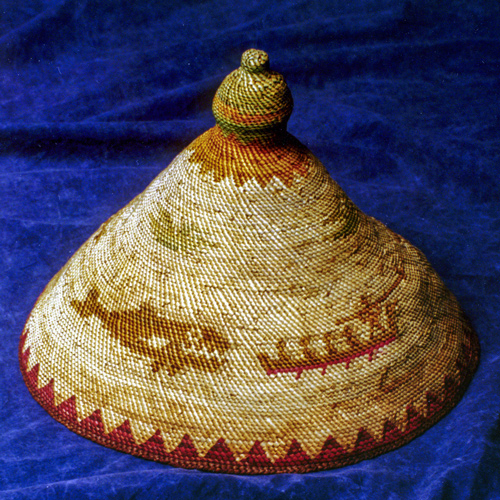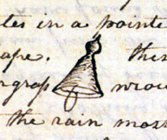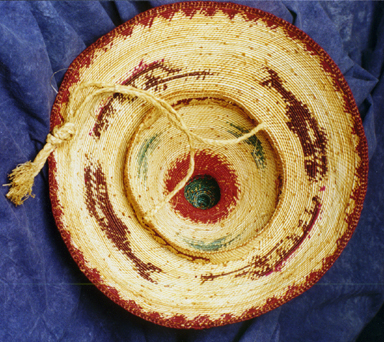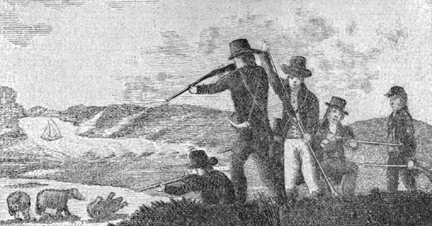High Style
The Chinook hat pictured first was acquired by the Fort Clatsop National Memorial from Quinault Indians on the Makah Reservation, at Neah Bay, Washington.
The decorative features, including the border, are made of dried-and-dyed beargrass leaves woven into the cedar-bark fabric. Notice that the tip of the hat somewhat resembles the tapered inflorescence (cluster) at the top of the beargrass stalk before the uppermost flowers have opened.[1]The natural model for the knob atop the hat is uncertain. Castle McLaughlin, Arts of Diplomacy (Seattle: University of Washington Press, 2003), 102-103.
By the time the Corps of Discovery arrived at the mouth of the Columbia River in early November 1805, the clothing they started with had long since worn out, and the leather replacements they had lately made were rotting quickly in the rainy coastal winter. They made new shirts, pants, and moccasins from the hides of the elk they killed for meat, but they could come up with nothing in the way of a head covering that was nearly as practical as the style perfected by the Clatsops and Chinooks.
“They wear a hat of a conic figure without a brim,” Lewis observed on January thirtieth:
confined on the head by means of a string which passes under the chin and is attatched to the two opsite sides of a secondary rim within the hat. the hat at top terminates in a pointed knob of a connic form also, or in this shape. these hats are made of the bark of cedar and beargrass wrought with the fingers so closely that it casts the rain most effectually in the shape which they give them for their own uce or that just described. on these hats they work various figures of different colours, but most commonly only black and white are employed. these figures are faint representations of whales the canoes and the harpoonneers striking them. sometimes squares dimonds triangles &c.
An Order for More
The headband and chin strap, also made of strips of cedar bark, held the hat securely in place.
One of six engravings in Patrick Gass‘s journal (1810)[2]Patrick Gass, A Journal of the Voyages and Travels of a Corps of Discovery . . . (Philadelphia: Mathew Carey, 1810).
Perhaps it was then that the captains ordered hats for the entire command, which were delivered three weeks later. On the twenty-second of February Lewis recounted:
We were visited today by two Clatsop women and two boys who brought a parsel of excellent hats made of Cedar bark and ornamented with beargrass. two of these hats had been made by measures which Capt Clark and myself had given one of the women some time since with a request to make each of us a hat; they fit us very well, and are in the form we desired them. we purchased all their hats and distributed them among the party.
Lewis mentioned on 19 January 1806 that the Clatsop and Chinook Indians had found a market among visiting sailors for hats in the style that was “in voge in the U States and Great Britain in 1800 & 1801 with a high Crown rather larger at the top than where it joins the brim, the brim narrow about 2 or 1-1/2 inches.” It could be that this was “the form we desired,” for Private Whitehouse allowed that they were “truly handsome.”[3]Robert J. Moore, Jr. and Michael Haynes, Tailor Made, Trail Worn: Army Life, Clothing & Weapons of the Corps of Discovery (Helena, Montana: Farcountry Press, 2003), 180-181. On the other hand, the conical style would have been more practical, considering the rainy winter weather the men had to endure. If the captains actually ordered the latter, one can imagine that some of the other men received them with a mixture of hilarity and and relief. Ironically, February twenty-second was one of the few relatively clear, calm and pleasant days they saw that entire Winter at Fort Clatsop.
Notes
| ↑1 | The natural model for the knob atop the hat is uncertain. Castle McLaughlin, Arts of Diplomacy (Seattle: University of Washington Press, 2003), 102-103. |
|---|---|
| ↑2 | Patrick Gass, A Journal of the Voyages and Travels of a Corps of Discovery . . . (Philadelphia: Mathew Carey, 1810). |
| ↑3 | Robert J. Moore, Jr. and Michael Haynes, Tailor Made, Trail Worn: Army Life, Clothing & Weapons of the Corps of Discovery (Helena, Montana: Farcountry Press, 2003), 180-181. |




